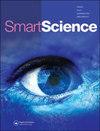Compressed sensing for ECG signal compression using DWT based sensing matrices
IF 1.4
Q2 MULTIDISCIPLINARY SCIENCES
引用次数: 0
Abstract
ABSTRACTIn this article, we have investigated the 1-D discrete wavelet transform (DWT)-based measurement matrices for electrocardiogram (ECG) compression. Moreover, the current work examines the suitability of the diverse DWT matrices, namely Symlets, Battle, Coiflets, Vaidyanathan, and Beylkin wavelet families, for ECG compression. Furthermore, this article shows the comparative performance study of the proposed DWT matrices with conventional deterministic and random measurement matrices. Overall, the Battle1 wavelet-based measurement matrices demonstrate the enhanced performance against the db3, coif5, and sym6 based measurement matrices in terms of Percentage Root-Mean Squared Difference (PRD), Root Mean Square Error (RMSE), and Signal-to-Noise Ratio (SNR). Finally, it was seen that the proposed Battle1 matrix demonstrates the improved performance against the conventional measurement matrices such as the Karhunen–Loeve transform (KLT), Discrete Cosine Transform (DCT) matrix, and random Hadamard measurement matrix. Thus, the result shows the adequacy of DWT measurement matrices for the compression of ECG.KEYWORDS: ECG compressionCompressed sensing (CS)Wavelet transform Disclosure statementNo potential conflict of interest was reported by the author(s).Ethics Approval and Consent to ParticipateThe authors declare that they have no human participants, their data or biological material used in this work.Consent for PublicationInformed consent was obtained from all authors included in the study.Supplementary materialSupplemental data for this article can be accessed online at https://doi.org/10.1080/23080477.2023.2258643Additional informationFundingThe author(s) reported that there is no funding associated with the work featured in this article.基于小波变换的心电信号压缩感知
摘要在本文中,我们研究了基于一维离散小波变换(DWT)的心电图压缩测量矩阵。此外,目前的工作考察了各种DWT矩阵,即Symlets, Battle, Coiflets, Vaidyanathan和Beylkin小波家族,对ECG压缩的适用性。此外,本文还展示了所提出的DWT矩阵与常规确定性测量矩阵和随机测量矩阵的性能对比研究。总体而言,基于Battle1小波的测量矩阵在百分比均方根差(PRD)、均方根误差(RMSE)和信噪比(SNR)方面比基于db3、coif5和sym6的测量矩阵表现出更强的性能。最后,我们可以看到,所提出的《Battle1》矩阵与传统的测量矩阵(如Karhunen-Loeve变换(KLT)、离散余弦变换(DCT)矩阵和随机Hadamard测量矩阵)相比,表现出了更好的性能。由此可见,小波变换测量矩阵对心电信号的压缩是适当的。关键词:心电压缩压缩感知(CS)小波变换披露声明作者未报告潜在利益冲突。作者声明他们没有人类参与者,他们的数据或生物材料在这项工作中使用。发表同意已获得研究中所有作者的知情同意。补充材料这篇文章的补充数据可以在网上访问https://doi.org/10.1080/23080477.2023.2258643Additional informationfunding .作者报告说,没有与这篇文章的工作相关的资金。
本文章由计算机程序翻译,如有差异,请以英文原文为准。
求助全文
约1分钟内获得全文
求助全文
来源期刊

Smart Science
Engineering-Engineering (all)
CiteScore
4.70
自引率
4.30%
发文量
21
期刊介绍:
Smart Science (ISSN 2308-0477) is an international, peer-reviewed journal that publishes significant original scientific researches, and reviews and analyses of current research and science policy. We welcome submissions of high quality papers from all fields of science and from any source. Articles of an interdisciplinary nature are particularly welcomed. Smart Science aims to be among the top multidisciplinary journals covering a broad spectrum of smart topics in the fields of materials science, chemistry, physics, engineering, medicine, and biology. Smart Science is currently focusing on the topics of Smart Manufacturing (CPS, IoT and AI) for Industry 4.0, Smart Energy and Smart Chemistry and Materials. Other specific research areas covered by the journal include, but are not limited to: 1. Smart Science in the Future 2. Smart Manufacturing: -Cyber-Physical System (CPS) -Internet of Things (IoT) and Internet of Brain (IoB) -Artificial Intelligence -Smart Computing -Smart Design/Machine -Smart Sensing -Smart Information and Networks 3. Smart Energy and Thermal/Fluidic Science 4. Smart Chemistry and Materials
 求助内容:
求助内容: 应助结果提醒方式:
应助结果提醒方式:


